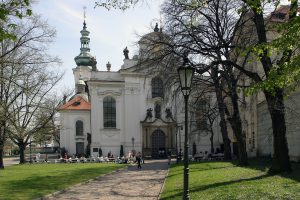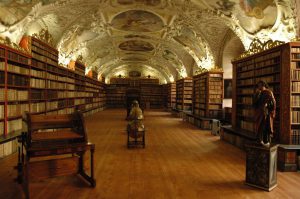The Strahov Monastery
By Tracy A. Burns
Not far from Prague Castle lies the Strahov Monastery, founded in the 12th century. Its library boasts two representative spaces. The picture gallery’s collection spans from the 14th to the 19th centuries. Also, several rooms of the monastery are open to the public: the Winter and Summer Refectories, the Chapter Hall, and the Romanesque Halls. Wolfgang Amadeus Mozart is even connected with Strahov: He played the organ in its Baroque basilica in 1789.
History
 The monastery did not survive unharmed throughout the centuries. It was plundered during the Hussite Wars in 1420 and was looted again during the Thirty Years’ War. In the 17th and 18th centuries, it took on a Baroque appearance. The construction of the library’s Philosophical Hall in Classicist style was not completed until the end of the 18th century, however.
The monastery did not survive unharmed throughout the centuries. It was plundered during the Hussite Wars in 1420 and was looted again during the Thirty Years’ War. In the 17th and 18th centuries, it took on a Baroque appearance. The construction of the library’s Philosophical Hall in Classicist style was not completed until the end of the 18th century, however.
The Library
The second oldest church library in Bohemia contains approximately 14,000 volumes. This includes 2,000 manuscripts – the Strahov Gospel from 860 AD ranks as the oldest. On the upper floor, the two roped-off representative spaces include the Theological Hall and the Philosophical Hall. The Theological Hall is decorated with rich stucco work and early 18th century frescoes dealing with themes taken from Psalms and The New Testament, for instance. Flanking the room is a collection of geographical and astronomical globes, some hailing from as early as the 16th century. The 32-meter-long Philosophical Hall is dominated by a ceiling fresco depicting the human spirit on a quest for Truth. Notice the figures of Adam and Eve, Solomon and David, and don’t overlook the historical personalities, either. Alexander of Macedonia, Socrates, and Aristotle are visible. The Ten Commandments’ tablets make an appearance, too. Scenes from mythology also find their way into the fresco. Another dominant feature of this library room is the 50,000 volumes about subjects such as mathematics, poetry, and astronomy, all set in exquisitely carved cabinets.
In the foyer set your eyes on an exhibition of illustrated manuscripts and miniature books, including Carda’s Old Testament from the 15th century and the richly decorated Missale of Louka hailing from 1483. The Pontifical of Albert of Šternberk, which goes back to the 14th century, is decorated with a picture of the dying Emperor Charles IV.
The Picture Gallery
While the library’s rooms are roped off, visitors are free to roam through the extensive picture gallery which covers the Gothic through Romanticist periods. The Gothic art section includes the “Madonna Sculpture” by the Swabbing Master circa 1490, the” Strahov Madonna” from the 14th century, and the 1530 painting “Judith” by master Lucas Cranach the Elder. The triptych of “The Ark of Doksany” by the Master of Doksany is composed of a woodcut winged altar dating from circa 1524. The gallery also impresses with its Dutch and Flemish art from the 16th and 17th centuries, such as works by Gerard Dou and Anton van Dyck. Baroque Czech masters that amaze include Petr Brandl, Vaclav Vavřinec Reiner and Karel Škréta.
The Convent Rooms
The rooms of the convent on the lower level include the Chapter Hall, boasting a Baroque altar, a ceiling fresco, and four large paintings on its side walls. The Winter Refectory features a richly stuccoed ceiling. Don’t overlook the ceiling fresco in the Summer Refectory, either.
The Church
Originally built as a Romanesque triple-nave basilica, the Church of the Assumption of Our Lady received a Baroque makeover in the 18th century. A marble high altar from 1768 dominates the main nave. Gilded carvings portraying the Assumption of Our Lady and the Holy Trinity figure prominently on the high altar, which is flanked by larger-than-life-size wooden statues of various saints. The basilica boasts 15 altars altogether. The vault portrays scenes about the Immaculate Conception of the Virgin Mary in eight large and 32 smaller frescoes. Also, 12 large frescoes depict the life of Saint Norbert.
Whether visitors are drawn to its library, picture gallery, basilica, or convent rooms, the Strahov Monastery is a historical sight in Prague that tourists should not omit from their itineraries.





